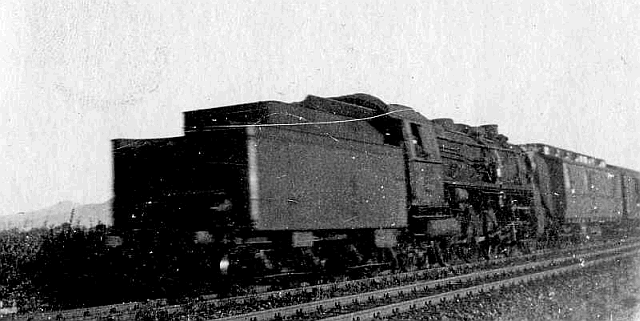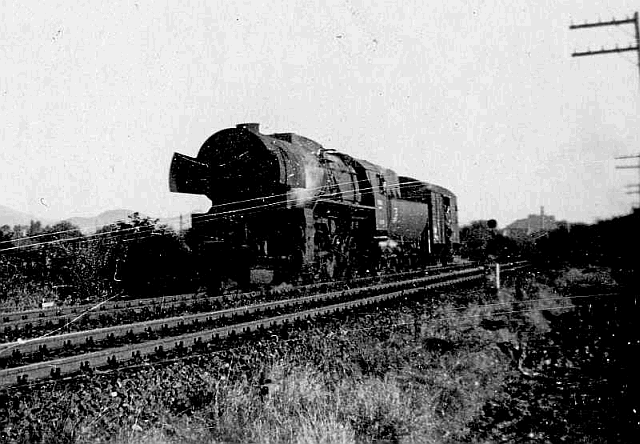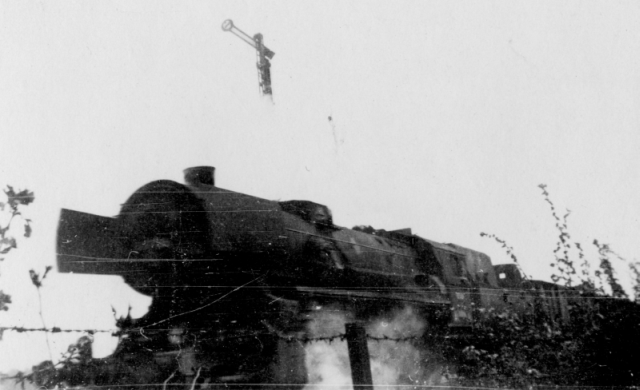
Previous page (July to September 1945)
AUTUMN 1945 (October to December)
For three weeks in September and October, seven of us from our four radar stations were at H.Q. at Bad Godesberg - at the Johanniter Hospital - to do a heavy technical building job. The Rhine west bank route from Köln through Bonn to the south, KBS 600, was in full use and I spent as much time as I could by the trackside near the hospital. I was still not willing to do any shed-bashing, nor did I try to get hold of a railway timetable. Most of the trains were freights and were in charge of BR 50s with the odd BR 42 or 52. 1 saw one P8; 38.1402 in Bonn Hbf. and altogether six BR 39s, the Prussian three-cylinder 2-8-2s, mostly on the few passenger trains made up of old Prussian four and six-wheeled coaches.
The shed at Bonn was a standard Reichsbahn half-moon round
a turntable and not, I think, damaged. On the one time I went close to it, I saw
my first loco in the pre-war black and red livery; 50.182 (Bw Köln-Nippes) with
large smoke deflector plates. Early in 1946, back in Winterberg, I obtained, from
local railway men, the February timetable for RBD Wuppertal and the complete
January Kursbuch for the whole American Occupation Zone. At that time, only
seven passenger trains ran in each direction through Bonn. Three were P-trains
from Köln to
Remagen, at the Zone border with the French Occupation Zone. D270
ran from Köln to
Mainz (depart 0755, arrive 1248) and three P-trains ran through
Remagen from Köln to
Koblenz. The north-bound services corresponded. The through
service from Köln to Frankfurt ran on the west bank of the Rhine, not from the
Hbf. but from Deutzerfeld, as the Hohenzollern Bridge was not restored until
later in 1946. According to the January timetable, this service was a
conditional daytime E-train taking from 0851 to 1538 for the journey. There
were also two through P-trains taking about nine hours for the journey with
stops at all stations. When
the job at Bonn was completed, we all returned to our units. I remained at Winterberg from mid-October 1945 until January 1947,
except for home leaves, two short leaves inside Germany and a four-week course
at Bückeburg. I have often regretted I did not do more in the short time I was
at Bad Godesberg and Bonn, but the whole district was alive with British troops,
from the Guards’ Division, and, with plenty of Military Police around, I decided
that too much obvious railway observation was a bit risky. But perhaps I was wrong.
I returned to Germany early in January 1946 but most of my journey was in darkness. We had the same P8 as before on the train to Neheim. Back in Winterberg I found there was plenty of snow at last, and almost everyone on the unit had obtained skis and was learning quickly. I took several good photos at this time in Winterberg station, including 58.1218 and 56.2776 in very sunny weather. The driver of the second engine had worked in America before the War and spoke perfect American-English.

BR39.055 near Bad Godesberg on 4th October 1945.

BR 42.1805 at Bad Godesberg on 4th October 1945.

52.2736 at Bad Godesberg on a northbound freight train 3rd October 1945.
Next page (January to February 1946)